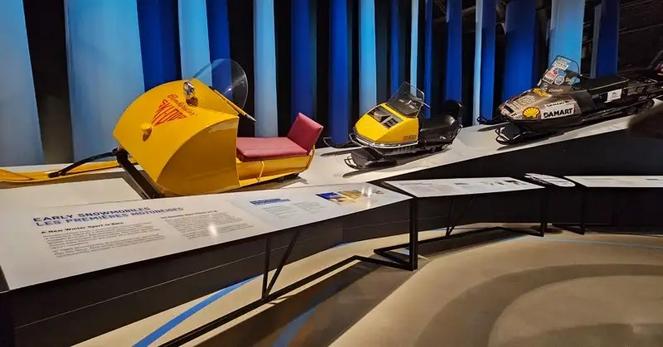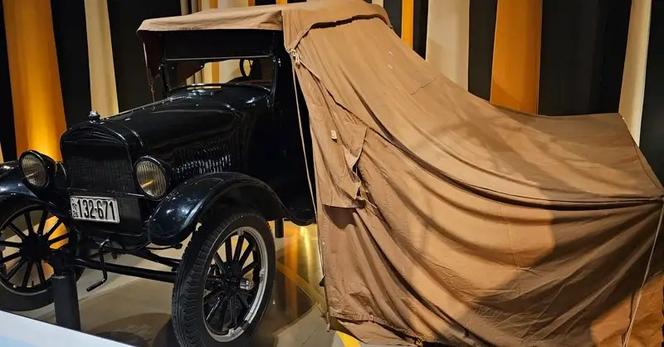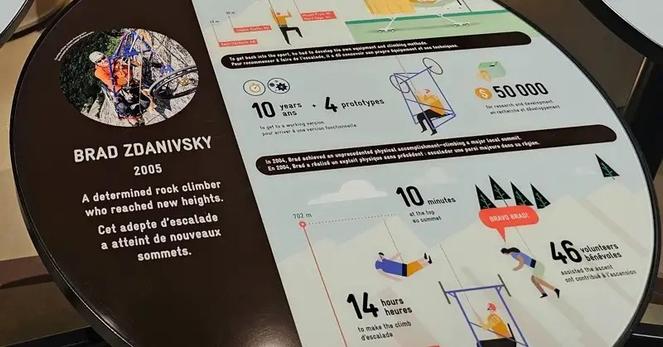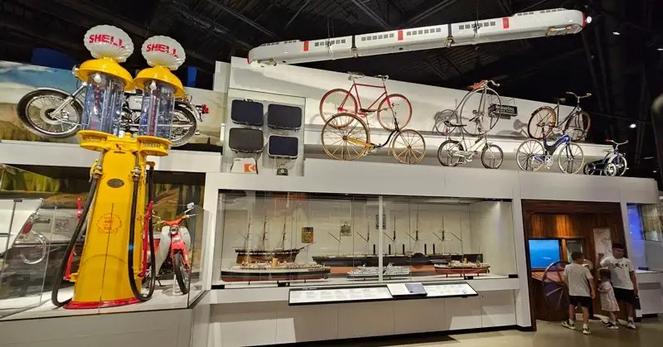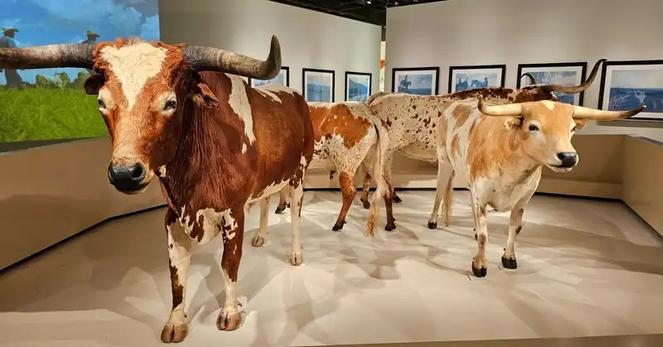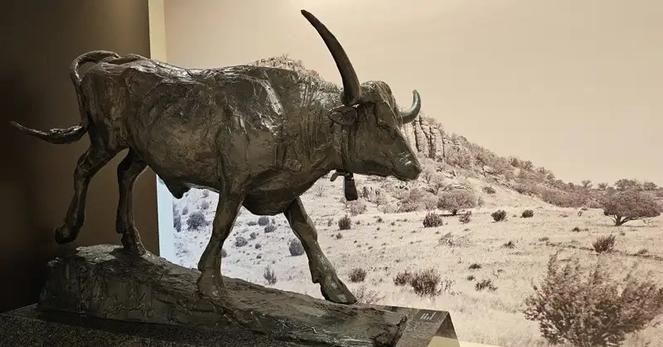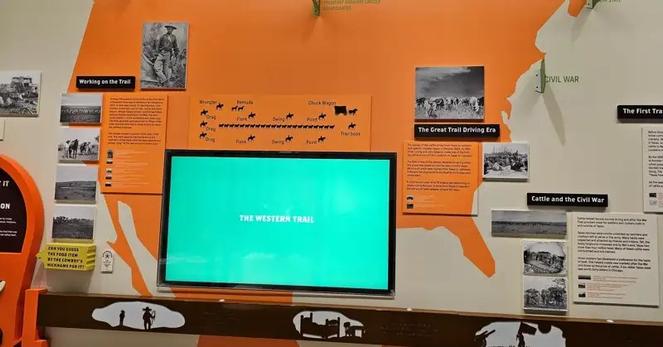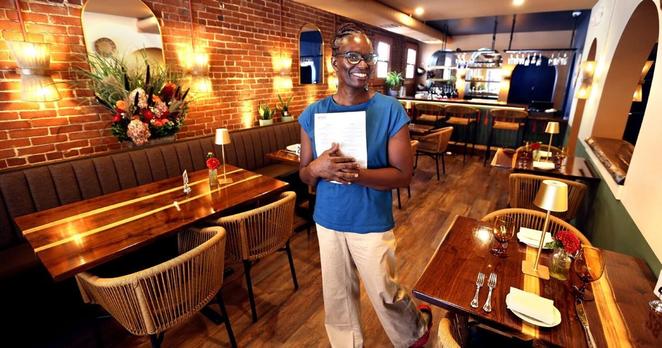Discover the Amazing Canada Science and Technology Museum
The Canada Science and Technology Museum showcases Canadian innovations. Located in Ottawa, Ontario, it’s one of seven national museums located in Canada’s capital city.
1926 Ford Model T Automobile with car camping auto tent. This car sold for about $400 or 11 weeks’ pay for an office worker. It cost an additional $20 for the auto tent. Photo by Linda Aksomitis.Linda’s Pick of the Exhibits
The Canada Science and Technology Museum was my favorite national museum. Its bright colors, energy, and exhibits reflected the Canada that I know and love.
My favorite exhibit? Into the Great Outdoors.
Into the Great Outdoors features — of course — various forms of transportation over the snow. That, of course, included snowmobiles.
1961 Ski-Doo snowmobile; 1972 Olympique 340 Ski-Doo snowmobile; snowmobile ridden to victory by Claude Marceau, Bertrand Dufour, and Paul Perron in the 1990, 2500 km (1553 miles) Harricana Race. Photo by Linda Aksomitis.But snowmobiles were late to party. The Indigenous people of North America perfected the snowshoe centuries earlier. You’ll see a variety of snowshoes in the museum. You can also play a game by pressing on handles to make figures sink into the snow to see what design works best.
Fast Fact: Ottawa receives the most snowfall annually (236 cm or 93 in). It's followed closely by Halifax, Iqaluit, and Montreal. What city has the lowest average rainfall? Regina. It receives just 106 cm or 42 in of snow. Winnipeg and Toronto only get a few centimeters more! ~ Canada Science and Technology Museum.Another display shows how Canadians have lead the way in adapting adventure sports. A number of people were featured including Brad Zdanivsky. He was a climber with partial quadriplegia from a spinal injury. But that didn’t stop him! He developed his own equipment and climbing method to continue enjoying his sport — rock climbing.
Brad Zdanivsky display in the Canada Science and Technology museum in Ottawa. Photo by Linda Aksomitis.Now that’s innovation!
Fast Fact: Canadians have been taking holidays "off the beaten path" since the 1940s. How? With the unique form of aviation called bush flying. When lakes and rivers are your runway, you can land in places other planes can't--no airport needed. ~ Canada Science and Technology MuseumWhat’s in the Canada Science and Technology Museum?
The Canada Science and Technology Museum was first created as part of the science and technology branch of the National Museum of Canada in 1966. It became a separate entity in 1968. Later, in 2000, the museum was renamed the Canada Science and Technology Museum.
Vintage gas pumps and bicycles in the Canada Science and Technology Museum. Photo by Linda Aksomitis.Today, the museum is part of Ingenium. Ingenium, a Canadian Crown Corporation, also manages The Canada Aviation and Space Museum and Canada Agriculture and Food. Their role is to preserve and promote Canada’s scientific and technological heritage.
Fast Fact: The Trans-Canada Highway crossed miles of rugged terrain across Canada. It was built between 1949 and 1965, taking the equivalent of about 2,400 people working seven days a week. How long is the Trans-Canada Highway? Seventy six hundred and thirty-one kilometres (4,742 miles). ~ Canada Science and Technology MuseumExhibition space covers about 7,400 sq. m (80,000 sq. ft), providing tons of space to explore. It’s home to over 150,000 artifacts.
Visitors to the museum start in Artifact Alley. What’s there? Lots of themed cases and immersive scenes like a winter wonderland and a ship’s wheel. Interactive experiences include taking command of a sci-fi spacecraft and using real woodworking tools. Altogether there are about 700 artifacts.
This sporty-looking Amphicar was driven by an Ontario family to their island cottage. Photo by Linda Aksomitis.One of the neat artifacts is a 1961 Amphicar. It’s the only amphibious vehicle ever created for the consumer market.
Permanent Displays
The museum has a number of permanent displays. You can explore the human body with the Medical Sensations Display. Or, you can look inside microscopic and telescopic displays in Hidden Worlds.
Display of lights and telescopes in the Canada Science and Technology Museum. Photo by Linda Aksomitis.Wonder how smart watches came about? The Wearable Tech display covers this and much more!
Love travel? Check out Steam: A World in Motion to learn more about how trains shaped Canada between 1900 and 1960.
Fast Fact: Thomas Wilby & Jack Haney made the first journey across Canada by automobile in 1912. Wilby was a British travel writer and Haney was his American driver and mechanic. They dealt with poor road conditions, mechanical problems, and non-existent roads. ~ Canada Science and Technology MuseumEver heard of the hitchBOT Robot? It was a Canadian robot designed to travel on its own!
What did the hitchBOT Robot do?The hitchBOT robot successfully hitchiked acorss Canada in 2014. The robot was created by Canadian researchers, David Harris Smith and Frauke Zeller. The robot was a little guy, just 1 metre (3.5 ft) tall and weighing 6.8 kg (15 lbs).
What was he made of? Well, a plastic beer bucket, flexible foam arms and legs, and a transparent head that had LED eyes and a mouth. It sort of looked like a human!
Its technology was surprising. Just a tablet computer, GPS, and artificial intelligence! The little robot couldn’t even walk. It was powered by solar power or an automobile cigarette lighter.
During the journey, the hitchBOT chatted with travel companions it met, took photos it uploaded for the team to share on its social media accounts, and reporting its GPS coordinates.
Music one of your interests? Explore the 150 year-old evolution of sound technology in Sound by Design. You’ll see various instruments and musical inventions in this display.
Fast Fact: Tin foil was the first material successfully used to record music! When? Way back in 1877 when Thomas Edison invented the phonograph. Tin foil was soft enough for etching, yet hard enough to be traced over with a needle for playback. However, the tin foil ripped easily. It could only be played a few times before the grooves wore down.You can also explore:
- From Earth to Us
- Technology in Our Lives
- ZOOOM – Children’s Innovation Zone
- Crazy Kitchen
- Exploreatek
Linda’s Road Trip Tips
Ottawa is the perfect destination for museum lovers! I was able to visit all seven national museums and the Diefenbunker Cold War Museum in my three days.
Six of the national museums were on the Hop On Hop Off bus route I used to get around the city.
The Canada Science and Technology Museum isn’t on the route.
So, I used an Uber from my hotel, along with another Uber ride to get back to the Hop On route.
If you’re looking for a snack or drink, check out the Savour Express café at the museum.
Since I was only starting my day, I opted for a drink to relax while I took advantage of electrical outlets in the seating area to charge my phone.
Pin me!You can save money visiting Ottawa’s museums by purchasing a one or three-day Ottawa Museums Pass.
Who Should Visit the Canada Science and Technology Museum?
The Canada Science and Technology Museum provides a wide range of exhibits with something for everyone. From the massive lighthouse Fresnel Lens to the Quiet Cube the stories are amazing.
Pin me!Kids will love the museum with all of its easily accessible displays and interactive elements.
There’s lots of room to move through the exhibits, making it an easy visit for strollers, wheelchairs, and walkers to see everything.
Seating is available in all areas if you get tired.
The museum was the first national public institution in Canada to receive the “Accessibility Certified Gold” rating under the Rick Hansen Foundation Accessibility Certification program.
I spent a couple of hours in the museum, but would have loved more time.
How Do You Visit the Canada Science and Technology Museum?
The museum is situated in the eastern part of Ottawa, allowing for more space and outdoor functions. It lies just south of Highway 417 (the Queensway), making it relatively easy to reach by car and public transit.
Parking: The museum has paid on-site parking by registering your license plate at a pay station or the Park Indigo app. Everyone who has a valid accessible parking permit can park in designated spots with no fee.Street Address: 1867 St. Laurent Blvd, Ottawa, Ontario, Canada.
The museum is open year-round. Check days and hours on the Ingenium website.
Keep up-to-date with what’s happening at the Canada Science and Technology Museum Facebook page.
Take a virtual tour with this Walkthrough the Canada Science and Technology Museum in 10 minutes on YouTube.
Plan your visit with Google Maps.
Read More Ontario Museum Reviews
Check out all these museum reviews for the Canadian province of Ontario!
Explore More Science Museums
-
Lafayette Science Museum: From Dinosaurs to the Space Age in Louisiana
-
McCormick Bridgehouse & Chicago River Museum: Chicago, Illinois
-
Moody Gardens: Resort & Fun Attractions with Pyramids in Galveston, Texas
-
Audubon Insectarium: Natural Science Museum in New Orleans, Louisiana
-
Glendive Dinosaur & Fossil Museum: 25+ Dinosaur Skeletons in Glendive, Montana
Acknowledgments
During my visit to Ottawa, Ontario, I received a national museum pass, and hop on, hop off bus pass, from Ottawa Tourism. I appreciate their support as it helps me provide this blog content free for everyone to read.
